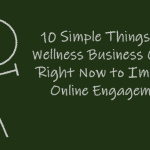The most common marketing mistakes, flawed assumptions and bad decisions made by health and wellness businesses:
1. Stale website content
If your website content hasn’t been refreshed in longer than you can remember, what you’re really saying is “We can’t afford to answer questions from people who want to buy our stuff” and “We can’t spare the time to connect with potential customers.”
Updating your site’s graphic design, your logo or adding Twitter and Facebook links and logos don’t count. Those are things you care about, not prospects.
Like it or not, your website is the go-to place where potential customers learn more about your services. In fact, it’s a critical part of the “Local Marketing Triangle“. Your website educates and helps close business. It deserves and requires ongoing attention. If you find yourself thinking “it’s too expensive” or “it takes too much time,” bump your blog and social activities down the list and focus on this instead. It’s that important.
Start by answering these seven questions every prospect has:
- Will this be right for me?
- What makes you special?
- What do other people think?
- What are my options?
- How can I try before I buy?
- What if I still have questions?
- Are you easy to do business with?
If you really don’t have the time or money, then it’s probably time to look at whether your business is truly viable.
2. Overreliance on social media
Let’s get one thing straight: social media can be a time suck.
Not just for potential customers randomly scrolling and clicking on the latest meme, but for you.
Yet, social can be useful—in the right place and at the right time in your customer’s journey.
It’s useful for maintaining relationships with current and former customers, and it can be useful for upselling those folks too—for example, via holiday marketing promotions.
But social media posts are not an effective lead generation method.
90%+ of prospects discover their local fitness or wellness business via Google Business Profile-related content and Google Ads. Social posts don’t even show up in Google results, so prospects generally never even consider them.
And while social advertising can raise awareness of the existence of your business, it doesn’t have the ability to target people with purchase intent the way Google Ads does, so it often generates a ton of impressions but very few serious prospects.
Bottom-line: to get more new customers, optimize every corner of your free Google Business Profile, invest in Google Ads, and make sure your website meaningfully answers those 7 questions we mentioned earlier.
3. Overreliance on organic SEO
“Our search firm got us to the top of Google in 3 weeks!”
At least, that’s what they’re telling you.
But ask yourself these questions:
How many new site visitors are getting, how many stick around for longer than a few seconds, and most importantly: how many of them are responding to your call to action—signing up for your newsletter, watching a video, reading an article? What did it cost you to get those unique actions?
Divide what you paid your SEO consultant by the number of “next steps” visitors actually took.
How many of those people turned into new paying customers and what did it cost you?
If the numbers are upside down, then you paid to get people to peek in your window—and walk past your door.
4. “We need customers NOW”
Businesses who think this way run the risk of discounting themselves into an early grave. (See #8 below).
Sure, you can always buy more customers by dropping your prices.
But it’s called “loss leader pricing” for a reason.
Think about it. How can your business can make money at that price?
And will customers happily pay higher prices after that initial purchase?
We all know that answer, right?
5. You’re not a $100 bill
You’re not right for everyone.
Your weight loss program is a home run for women with emotional eating problems. But that’s not every woman.
And what about men? What works for them is usually quite different. And not all men want the same thing, either.
Not to mention cultural and ethnic differences, psychosocial differences, differences in what people are able and willing to pay, their receptiveness to online vs face-to-face programs, the unique concerns associated with a long list of chronic health conditions and on and on.
You can’t be everything to everybody. Embrace the fact that your business isn’t everyone’s cup of tea and double-down on the kinds of customers you serve best.
6. Trying to do everything for everyone
A lot of potential clients tell us they can’t make money focusing on a niche.
Actually, it’s usually the only way you can make money.
Different market segments have different needs.
If you try to market to everyone, your message will be so generic that it doesn’t click with anyone.
If you try to serve everyone, regardless of their particular goals, needs, challenges, etc., you won’t do a great job of meeting anyone’s needs.
This is why generalists—like big box national-chain gyms—often find themselves caught up in discounting and price wars. When you’re average at everything and great at nothing, competing on price is all that’s left.
7. Overthinking your name or logo
This is probably the single most common mistake new health, fitness, and wellness businesses make.
They spend untold time agonizing over whether a particular shade of green signifies “growth”, “a new start”, “empowerment”, or another highly conceptual idea.
What you should be focusing on is:
- Does it say what you do and for whom?
- Is it readable from the parking lot, online, and anywhere else it might appear?
- Is it unambiguous?
“Srivi Ashtanga Yoga” is much more helpful in any color or font than a stylized picture of person morphing into a lotus blossom.
What you do for customers is the most important thing. If you’re bad at communicating that, it doesn’t matter if your name is “Free $100 Bill.”
8. Overreliance on Groupon or other daily deals
Try it if you just can’t stop yourself, but most folks who use it will only visit you once and you’ll lose money on them and more than likely tick off your current customers too. But you do you. 🤪
9. Single-channel focus
Marketing is additive (not addictive). All other things being equal, sending one postcard, one email, and holding one public event is better than sending three emails. It’s more memorable and it gives you three different ways to catch a potential client’s eye.
No argument, the simplicity of relying on only one channel, like email or your Facebook business page, is appealing. But unfortunately, we live in a world where different people are drawn to different channels. You need to cast a wide net.
More on postcard marketing and direct mail.
10. Resistance to change
We once had a prospect who desperately wanted more customers. But they weren’t willing to change anything they were doing.
If you want different results, you must change what you’re doing. You may need to overhaul your programs and services, raise or lower your pricing, target some customers and drop others, revisit your costs or rethink your marketing activities.
Anything else is just threatening to hold your breath until you turn blue. You won’t get anything from anybody and eventually, you’ll collapse.
If you’re unhappy with your business results—but you’re pretty sure everything you’re doing is right—start by changing your mindset.
11. Buying an email list
Don’t ever do this. That list will be full of strangers who never heard of you and have zero interest in your services. Many will report your emails as spam and then you’ll have email delivery problems in the future.
Here’s 50+ ways that your wellness business can build its own email lists.
12. Delegating marketing to your admin/intern/VA
And the guy who mows your lawn can probably fix your computer, too.
True, we all know how to write—but choosing the right words at the right time, in the right quantity, to influence and persuade people to buy your wellness services is a blend of art, science and experience.
Your virtual assistant may be a Photoshop whiz, but that doesn’t mean they’re a great copywriter or marketing strategist.
13. Writing your own reviews
Eek! First, it’s sleazy. Second, it nearly always sounds fake. Third and most important, it’s a terms of service violation that often leads to suspension of your business profile. Fourth, it’s much easier to get real customers to do it anyway!
14. Focusing only on video marketing
Tiktok! Youtube! Vimeo! Wistia! Yay!
Video has lots of potential when it’s used intelligently as part of a coherent marketing strategy. But if it’s just standard exercise demos or nutrition tips on YouTube that aren’t a coherent part of your marketing plan, it’s not worth the effort and cost to duplicate content that a gazillion other folks have already created.
15. Using keywords as your business name
This particular headache is very common among health and wellness businesses, and according to our recent national survey of health, fitness, and wellness Google Business Profile in four market segments, it’s especially common among nutrition and weight loss businesses.
We’ve actually seen Google Business Profiles with names like: “Dr. Jane Doe, Women’s Weight Loss, Toning, Sculpting, HCG, Nutritional Counseling, HealthyWeight LLC.”
This poses two problems. First, that’s probably not the real business name—and that’s a Google Business Profile TOS violation. Second, that’s not a name customers are likely to remember or be able to search for.
When you choose a new business name, think of it this way: what’s the smallest collection of words you can put on your storefront that will help customers recognize you and your value? Would “Dr. Doe’s Women’s Weight Loss” work? How about “HealthyWeight HCG Clinic”?
Choosing a name that uses only phrases and words in widespread usage is also a non-winning strategy, simply because so many unrelated searches use that term that it makes it very difficult to target Google Ads appropriately.
One final naming pro tip: Don’t try to game Google when you name your business. Google has begun demoting listings for businesses with names like “Urgent Care Near Me” or “Yoga Near Me.”
16. Always chasing the next “great idea”
100 projects 50% done is not the same as 50 projects 100% done.
Continually adding cool new stuff and improving what you’re already doing is truly a key to success.
But.
Write it down, file that piece of paper and keep working on the stuff you already have in progress.
Jumping from one good idea to another without ever bringing any of them to maturity is not healthy for your business.
17. Starving everything except program development
Health and wellness businesses are never done. They always see ways to improve the programs and services they offer clients.
And that’s not a bad thing. Until it takes up all the oxygen in the room.
A great program is just the start of what it takes to make a business successful.
It’s just table stakes—or as the mathematicians say, “necessary but not sufficient.”
You’ve also got to be able to find paying customers for that program or service, which means setting aside a budget for marketing. You’ve got to be able to close sales with truly interested prospects. That means budgeting for sales efforts.
And finally, you’ve got to be able to deliver that service consistently with a price and cost structure that produce reliable profits. That means budgeting for operations staff and other resources.




